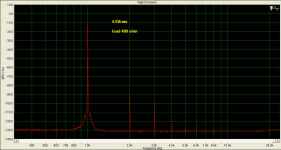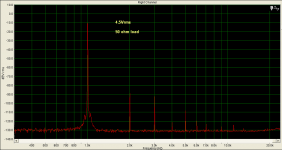In any class AB-2 output stage, 7th harmonic is an easy probability. In fact, it is almost impossible for it not to be there. This is because it is almost impossible to make a perfect transition between one device turning off and the other turning on. Even idealized curves show this to be so. IF you have only 0.5ma Iq on your output stage, because your current budget has been used elsewhere, and you have to drive a 600 ohm load, for example, then you MUST get a transition at about 0.6V out, peak. If you are below this peak, then you are still in the class A region (more or less), but if you exceed this level then you must go through a rough patch. How rough is my question, since I expect at least 12V peak voltage or 20 times more level, before I might find another source of serious distortion in this output stage. Can you appreciate that 20 times lower level than peak is about where the average signal may actually be in a real circuit? Is it so mysterious, or difficult to comprehend why I ask this question?
Steve Eddy said:
Great. Then continue to do so. If that works for you, fine. No skin off my nose. Just don't do so while asserting that those who may prefer to use transformers and may prefer the sound they achieve when they use transformers are little more than a bunch of hearing-impaired, band aid applying morons.
What is this magical sound of transformers that we keep hearing about ?? Can you please elaborate ??
With 4.5Vrms and 400R load I am in class A, for the reason of 11mA bias. Till 22mA peak, the output stage is in class A. That means, for any real life line stage load, it is in class A for any output amplitude below clipping.
Here we go. Now I have forced the output stage into AB. The load is 50R + 3R series resistor = 53 ohm. Again 4.5Vrms.
FB is only 10dB, so it does not suppress high orders much.
You can see the 7th. Most line stage outputs would collapse under these conditions.
FB is only 10dB, so it does not suppress high orders much.
You can see the 7th. Most line stage outputs would collapse under these conditions.
Attachments
JC,
what's the point?
You, PMA and many others choose to go discrete to avoid the compromises that IC forces upon us.
We end up with different compromises and hopefully better solutions.
what's the point?
You, PMA and many others choose to go discrete to avoid the compromises that IC forces upon us.
We end up with different compromises and hopefully better solutions.
I am designing with IC's as we speak. Don't you understand that this is VERY important to me? I will find a solution, if it exists, but so far, no help from the IC's designer.
Hi,
but this is Blowtorch and PMA has introduced a close relative judging by what I have understood so far.
We are not reading this thread to learn how to get into designing ICs. I hope you're not here for that either.
but this is Blowtorch and PMA has introduced a close relative judging by what I have understood so far.
We are not reading this thread to learn how to get into designing ICs. I hope you're not here for that either.
I'm not here to learn about transformers either, but I have learned a thing or two. Maybe, you could learn something about the limitations of IC's and then come to understand why my BEST designs are still discrete. Interfering with my questions doesn't teach anyone anything.
what's the point in asking PMA to consider 0.5mA as his limitation?
Will it get, either him or us, closer to a better solution for a Blowtorch style preamp?
How is that interfering with your question?
Will it get, either him or us, closer to a better solution for a Blowtorch style preamp?
How is that interfering with your question?
Excellent "tutorial", Pavel.
Thanks for sharing.
Finally, the 7th is there - and more even so the 9th. I think that
John mentioned the 9th somewhere else in this thread, and the 9th is also a "nasty one".
You have made yourself a nice headphone amp!
My HD650:s would be a piece of cake to drive for your amp....
Spontaneously, I feel that 12mA is too little for the BD-transistors, but maybe I am a bias addict 😉
How does distortion simulations compare to your real measurements?
Regards,
Sigurd
Thanks for sharing.
Finally, the 7th is there - and more even so the 9th. I think that
John mentioned the 9th somewhere else in this thread, and the 9th is also a "nasty one".
You have made yourself a nice headphone amp!
My HD650:s would be a piece of cake to drive for your amp....
Spontaneously, I feel that 12mA is too little for the BD-transistors, but maybe I am a bias addict 😉
How does distortion simulations compare to your real measurements?
Regards,
Sigurd
PMA said:Here we go. Now I have forced the output stage into AB. The load is 50R + 3R series resistor = 53 ohm. Again 4.5Vrms.
FB is only 10dB, so it does not suppress high orders much.
You can see the 7th. Most line stage outputs would collapse under these conditions.
Just for the record, I have played with the sole output stage in simulation. The 7th has appeared after the O/P has left class A, exactly as John had said. There was no 7th even for higher amplitudes, in case the output was kept in class A.
It helps me simulate what Scott's output stage is really doing. You will never learn anything more about the Blowtorch from me, so you had better get used to it. Actually, I can extrapolate from PMA's work, already done, myself, but the rest of you might have more difficulty. That is why I asked PMA to help me teach the rest of you something useful and important. Mainly, that Class AB-2 designs usually generate some measurable amount of 7th harmonic. 7th harmonic is the most critical harmonic that generates real problems in hi fi reproduction. Personally I use 50ma for my discrete preamp output stages, therefore I have no problem with 7th harmonic, but I am forced to use these IC's for an inexpensive phono stage. What a headache.
John - if you let us know more about your problem, someone here might have some clues to a solution. I think that many here would like to "pay you back" by giving you some idea to your problem.
Regards,
Sigurd
Regards,
Sigurd
john curl said:I am designing with IC's as we speak. Don't you understand that this is VERY important to me? I will find a solution, if it exists, but so far, no help from the IC's designer.
Sigurd Ruschkow said:
Spontaneously, I feel that 12mA is too little for the BD-transistors, but maybe I am a bias addict 😉
How does distortion simulations compare to your real measurements?
Regards,
Sigurd
I can easily bias more, but still do not have heatsinks, they are to arrive from Fischer next week.
The simulation fits to a degree. Now I have 2N5551/2N5401 BJTs in input complementary-differential. Measured results are better than the simulated ones. However, simulation with BC547/557 suggests more than 20dB improvement in 2nd and 3rd. I will try them with final PCB end of next week.
john curl said:I am designing with IC's as we speak. Don't you understand that this is VERY important to me? I will find a solution, if it exists, but so far, no help from the IC's designer.
John, If you have about $1,000,000 NRE we might be able to run you a lot with 50mA bias.
Steve Eddy said:The kind that I enjoy.
se
OK, I just have never heard of anyone "getting off" by listening to their audio system before.
I guess that would be one way to advertise your beloved transformers 😀
john curl said:Personally I use 50ma for my discrete preamp output stages, therefore I have no problem with 7th harmonic, but I am forced to use these IC's for an inexpensive phono stage. What a headache.
Hi John,
a friend of mine has designed and produced a small series of IC's for a measurement application (extremely linear DAC buffer up to 10 MHz) working in class A on the output at 500 Ohm load and 2 V RMS. It sports an external compensation and at gain 30 has GBW about 10 GHz and THD -106 dB @ 2V RMS 1MHz, 2nd and 3rd only. The chip is idling at 20 mA, supply is +/- 9V. I probably could ask him for a sample 🙂 . These chips would not be cheap thought, about $20-25 each, I suppose.
Cheers
Alex
- Status
- Not open for further replies.
- Home
- Amplifiers
- Solid State
- John Curl's Blowtorch preamplifier

